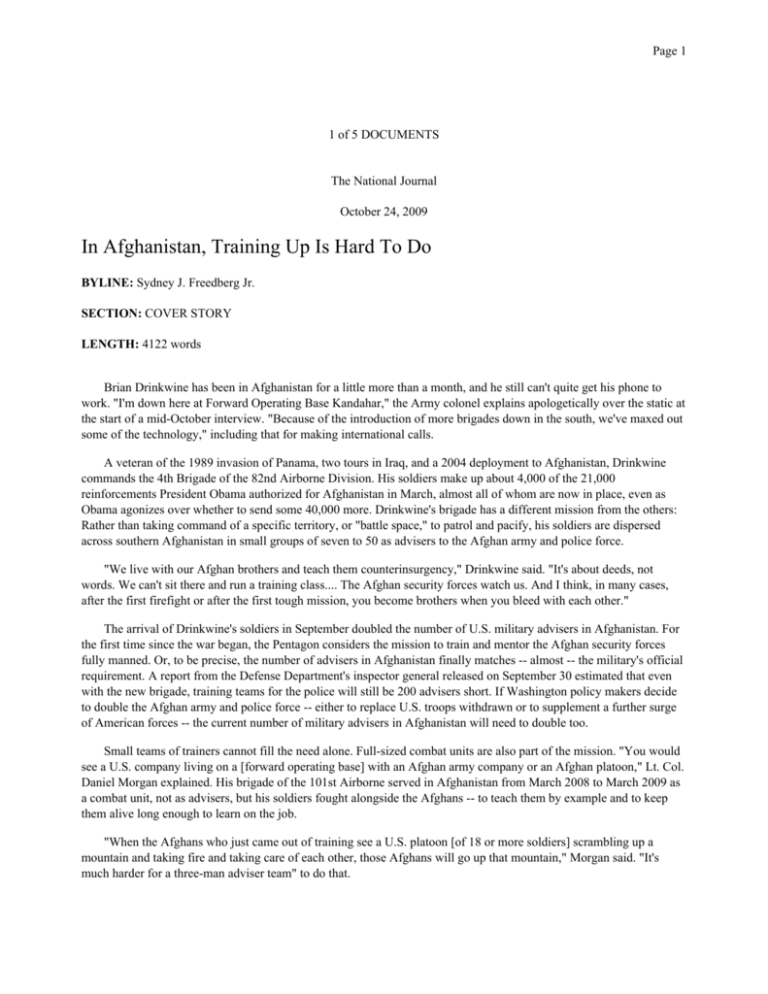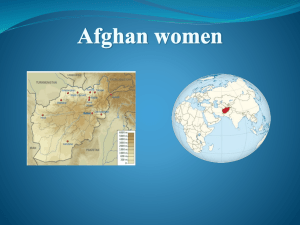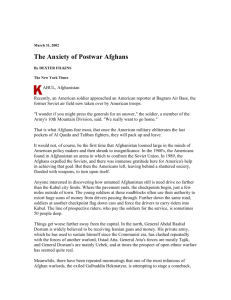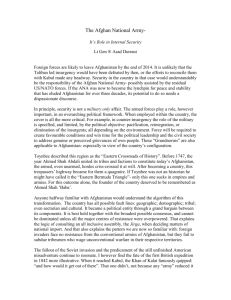
Page 1
1 of 5 DOCUMENTS
The National Journal
October 24, 2009
In Afghanistan, Training Up Is Hard To Do
BYLINE: Sydney J. Freedberg Jr.
SECTION: COVER STORY
LENGTH: 4122 words
Brian Drinkwine has been in Afghanistan for a little more than a month, and he still can't quite get his phone to
work. "I'm down here at Forward Operating Base Kandahar," the Army colonel explains apologetically over the static at
the start of a mid-October interview. "Because of the introduction of more brigades down in the south, we've maxed out
some of the technology," including that for making international calls.
A veteran of the 1989 invasion of Panama, two tours in Iraq, and a 2004 deployment to Afghanistan, Drinkwine
commands the 4th Brigade of the 82nd Airborne Division. His soldiers make up about 4,000 of the 21,000
reinforcements President Obama authorized for Afghanistan in March, almost all of whom are now in place, even as
Obama agonizes over whether to send some 40,000 more. Drinkwine's brigade has a different mission from the others:
Rather than taking command of a specific territory, or "battle space," to patrol and pacify, his soldiers are dispersed
across southern Afghanistan in small groups of seven to 50 as advisers to the Afghan army and police force.
"We live with our Afghan brothers and teach them counterinsurgency," Drinkwine said. "It's about deeds, not
words. We can't sit there and run a training class.... The Afghan security forces watch us. And I think, in many cases,
after the first firefight or after the first tough mission, you become brothers when you bleed with each other."
The arrival of Drinkwine's soldiers in September doubled the number of U.S. military advisers in Afghanistan. For
the first time since the war began, the Pentagon considers the mission to train and mentor the Afghan security forces
fully manned. Or, to be precise, the number of advisers in Afghanistan finally matches -- almost -- the military's official
requirement. A report from the Defense Department's inspector general released on September 30 estimated that even
with the new brigade, training teams for the police will still be 200 advisers short. If Washington policy makers decide
to double the Afghan army and police force -- either to replace U.S. troops withdrawn or to supplement a further surge
of American forces -- the current number of military advisers in Afghanistan will need to double too.
Small teams of trainers cannot fill the need alone. Full-sized combat units are also part of the mission. "You would
see a U.S. company living on a [forward operating base] with an Afghan army company or an Afghan platoon," Lt. Col.
Daniel Morgan explained. His brigade of the 101st Airborne served in Afghanistan from March 2008 to March 2009 as
a combat unit, not as advisers, but his soldiers fought alongside the Afghans -- to teach them by example and to keep
them alive long enough to learn on the job.
"When the Afghans who just came out of training see a U.S. platoon [of 18 or more soldiers] scrambling up a
mountain and taking fire and taking care of each other, those Afghans will go up that mountain," Morgan said. "It's
much harder for a three-man adviser team" to do that.
Page 2
In Afghanistan, Training Up Is Hard To Do The National Journal October 24, 2009
Here is the paradox facing the president. In the long run, it is true that "as the Afghans stand up, we will stand
down," to adapt the cliche that is, after many years, finally coming true in Iraq. But that equation is trueonlyover the
long run. In the next few years, at least, getting more Afghans ready to fight requires deploying more, not fewer,
Americans to train them in boot camp, to advise them in the field, and above all, to fight alongside them. In the near
term, training more Afghans is not analternativeto sending more Americans: Achieving the goalrequiresmore
Americans.
Story Continues Below Chart
The Iraq Experience
We know that training the Afghans to defend themselves will require more Americans, not fewer, because we have
tried it the other way. In 2003 and 2004, the United States attempted to build Iraqi forces on the cheap and to hand over
security to them prematurely while drawing down American troops. When fighting in Falluja triggered uprisings across
the country, the undertrained and undersupported Iraqi units mostly dissolved -- with some significant exceptions.
"When we had U.S. forces, for example in An Najaf, the police stood there and fought," recalled Brig. Gen. David
Quantock, who in 2004 commanded a military police brigade tasked with training Iraqi cops -- on top of patrolling the
highways and reforming Abu Ghraib prison. "In those stations where there was no [U.S.] presence, like in Kufa, those
stations were lost."
As the Iraqi debacle of 2004 showed, advising cannot be neatly divorced from fighting. Before drawing down, U.S.
forces had to not only build up their local allies but also grind down the threat to a level low enough that the nascent
indigenous units could tackle it on their own.
Americans naturally prefer to focus on the handoff, not the fight. Even the names of the commands overseeing
training for Iraqis and Afghans optimistically signal that goal: "Multi-National SecurityTransitionCommand-Iraq" and
"Combined SecurityTransitionCommand-Afghanistan." But "you never get to that level if you don't improve security,"
said retired Lt. Gen. James Dubik, who led the transition command in Iraq at the height of the violence. "That was part
of our discussion in 2007," he recalled: "We've got to get out of the 'transition' business, because if we don't win the
war, there'll be nothing to transition to."
In 2007, the surge of 30,000 U.S. troops to Iraq and the wooing of Sunni Arabs away from the insurgency brought
the threat down as the capacity of Iraqi security forces rose. In Afghanistan, threat and capacity are far from that happy
meeting place.
Part of the problem is that the Bush administration, rightly or wrongly, switched its focus from Afghanistan to Iraq
in 2002, a priority only recently reversed. But a contributing factor has been the U.S. Army's institutional disdain,
outside the relatively small Special Forces, for working with untrained foreign rabble, a bias that has taken thousands of
U.S. casualties to turn around. Afghanistan was an afterthought to Iraq, and so was mentoring indigenous forces in
either country, which meant that training Afghan soldiers was an afterthought to an afterthought. Training Afghan
police officers, who take more than twice as many casualties as the better-supported army, was an afterthought to an
afterthought to an afterthought. Drinkwine's brigade of advisers is just a down payment on reversing eight years of
underinvestment in Afghanistan. And the Afghans start off deeper in the hole than the Iraqis ever were.
The Afghans Can Fight
"There's a difference between Afghans and Iraqis," said Morgan, who has served in both countries. "The Afghans
have been fighting for a long time, and you can see it in their eyes. They are not afraid to fight."
For the Americans who are mentoring Afghan fighters, the good news is that Afghanistan has been at war for 30
years. The bad news is that Afghanistan has been at war for 30 years. When the United States intervened in that conflict
Page 3
In Afghanistan, Training Up Is Hard To Do The National Journal October 24, 2009
in October 2001, the military found plenty of hardenedwarriorseager to fight the Taliban, but precious fewsoldierswith
the discipline, technical skills, or the institutional infrastructure -- from boot camps to supply lines to payroll systems -to stabilize the country. After 9/11, a relative handful of Special Operations troops and CIA operatives needed just two
months to mobilize the Northern Alliance warlords to take Kabul. Eight years later, mobilizing a force to keep Kabul is
proving harder.
"I worked with one of their battalion commanders. He looked just like Sean Connery, only he was about 5 feet tall,"
said Spencer Kohlheim, a senior sergeant in the Indiana National Guard who trained Afghan army scouts in 2004-05,
when the three-year-old army was less than 30,000 strong. That 5-foot Afghan commander had two decades' experience
fighting the Soviets and then the Taliban.
By contrast, "your lower enlisted, your privates, they were right off the farm," Kohlheim said. "I gave them all
notebooks and pens and paper; by lunchtime the notebooks were all filled up with pictures they were drawing."
Once Kohlheim adapted his training techniques to the Afghans, however, he found them to be fast learners,
illiterate or not. "If they do something hands-on, they start picking it up real quick," he said. "That was probably one of
the most rewarding things I think I've ever done as a soldier. When you can teach someone with no education
whatsoever to call and adjust [artillery] fire, it makes you feel pretty good."
Such hands-on learning has made the Afghan national army an effective infantry force, one small unit of foot
soldiers at a time. Of the 90 battalions, orkandaks,fielded to date, the U.S. military considers only three unready for
combat -- one of those is fresh from basic training -- and 28, a third of the total, are rated capable of operating without
U.S. support.
At levels of complexity beyond the individual infantry battalion of 600 men, however, the picture darkens. Just 43
percent of Afghan men can read, compared with 84 percent in Iraq. Afghan officers are officially required to be literate,
but so many are not that American advisers often have to fill out supply request forms, according to the September
report from the Pentagon inspector general.
"They don't make the logistics system work," said Maj. Gen. Richard Formica, the outgoing chief of Combined
Security Transition Command-Afghanistan, which oversees Afghan army and police force development. "What you're
seeing is the coalition guys coming to the rescue and providing the stuff" through U.S. or NATO supply lines.
When shipments do move through the Afghan system, corruption takes bites along the way. Police units, in
particular, sometimes end up short of weapons and short of gasoline to fuel patrols. "Fuel is money, and fuel has a way
of disappearing over there," said Maj. Andrew Ashley, who advised the Afghan police in late 2008 and early 2009.
Winter clothing, pickup trucks, and even military equipment are known to go missing, as well. In 2005, Kohlheim's
Afghan soldiers even sold their spare uniforms. In a cash economy, payrolls are particularly vulnerable. "Theoretically,
the goal is to get them set up for electronic payment," Ashley said, "but that assumes someone is able to access a bank."
The Troubled Afghan Police
All of the institutional problems hit the Afghan police force even harder than the army. Dispersed in 365 districts
across the country, the so-called Afghan national police are in fact mostly a patchwork of locally based forces, recruited
from the communities they serve. Less well trained, paid, and equipped than the army, the district police operate far
from Kabul's support or oversight but dangerously close to local potentates, criminals, and insurgents. From January
2007 to October 2008, the Defense IG reported, while U.S. and NATO forces suffered 464 troops killed in action and
the Afghan army lost 505, the Afghan national police lost 1,215.
"The army is, I'd say, five to six years further along in development than the police," Formica said. "Every army
unit we have has been mentored [by U.S. or NATO advisers]. With the police, we haven't had that luxury. We've got
about 20 percent of the 365 police districts that have embedded mentor teams."
Page 4
In Afghanistan, Training Up Is Hard To Do The National Journal October 24, 2009
To bring cops up to a national standard, a reform program called "Focused District Development" pulls them out of
their home districts and sends them to national training centers for an intensive eight-week course. (Elite units called the
Civil Order Police, or Afghan Gendarmerie, fill in while the local cops are gone.) So far, however, only 66 of the 365
districts nationwide have completed the training, all of them in relatively accessible places along Afghanistan's major
national highway, the so-called ring road.
Formica's command still rates those 66 police districts significantly lower than the Afghan army.(See graphic, p.
26.)Yet, other important measures of success are evident. When the retrained police return to their districts, their death
rates drop, on average, by 60 percent -- and casualties among local civilians decrease by 66 percent.
Outside help can indeed make a difference, but only if it is there. So far, U.S. or NATO advisers have worked with
just one-fifth of Afghanistan's police districts. Another variable is whether the advisers find adequate leadership once
they get to a district.
In a country without strong institutions, personalities matter above all. So the true story of Afghan security forces is
not one of a uniformly excellent army and a universally inept police force. It is about dramatic variation from one army
battalion or police district to the next, and sometimes even within the same unit at different times, depending on who is
in charge.
In the six months that U.S. Army Capt. Christian Mitchell spent with an Afghan national army company in 2007
and 2008, it had two very different commanders. The first was a veteran Northern Alliance fighter named Atullah. "He
cared about the guys in his company, he cared about training them, and he wanted to learn," Mitchell said. "I stayed by
his side, but we got to the point where he was running things." Then Atullah got a better posting and was succeeded by
a defector from the Taliban named Baqi. "He took all the pride out of the company," Mitchell lamented. "He didn't
respect the soldiers. When pay came in, large chunks of money would come up missing." And on combat patrols, time
and again, Mitchell had to shove Baqi aside and take over before the Afghan commander got people killed. "It was like
starting from scratch."
Later in his tour, Mitchell moved to an Afghan army brigade headquarters where the change was from bad to good.
"When I went over there, they actually had just removed the old operations officer for being corrupt, and they had
moved over a new guy who was formerly the intelligence officer. He was a great guy, a really smart guy.... We made a
lot of headway."
Drinkwine said, "Where there are good Afghan leaders, really good Afghan leaders, it's infectious in their unit. And
the best way to develop Afghan leaders is to surround them with good leaders." That is where the U.S. forces come in.
Teaching By Fighting
"Adviser" is a low-key job title. But when the country being advised is in the middle of a war, advisers do not
spend most of their time giving advice.
"We'd go out and get in a fight; we'd fight for a couple of hours until we started to run out of ammo for the
Afghans; and then we'd fall back to the hilltop and call in air strikes for the rest of the evening," Maj. Robert Gully said.
"We'd do that almost every day."
Now an instructor at the Army's school for advisers at Fort Polk in Louisiana, Gully is an Army Special Forces
officer with two tours in Afghanistan and one in Iraq, as well as pre-9/11 training missions in Bosnia and the Baltics. He
spent nine months in 2006-07 commanding an "A-team" of 12 Americans advising about 80 Afghan national army
soldiers. One of his men died -- "it broke my heart because he was a really good friend" -- as did five of the Afghans.
The unit had originally been stationed in a quiet area around the northern city of Mazar-i-Sharif, where Gully could
not get the Afghans to take his training program seriously. "A lot of times the attitude was, 'Why do we need to train?
Page 5
In Afghanistan, Training Up Is Hard To Do The National Journal October 24, 2009
We don't need to train -- wearesoldiers.' " Then Gully's unit moved to the Taliban-controlled Panjaway Valley south of
Kandahar, where it was in constant combat. "That was much more effective than trying to convince them back in
Mazar-i-Sharif why they should lay on the ground and shoot their gun at a target," Gully said dryly. Once the Afghans
deployed to the Panjaway Valley, "they would really listen, but they were also so fearful at times that they didn't want to
move." To get them to act, much of Gully's "adviser" job boiled down to teaching by example.
"Most of the guys on my team had been to Iraq and Afghanistan multiple times" and "enjoyed being in action,"
Gully said. "That was the inspirational part for the Afghan guys, because when we get in a fight, my guys are making
jokes and smiling. [The Afghans'] apprehension about engaging the enemy, some of that started to go away."
Ashley, the police adviser, said, "I don't think 'training' is the right word for this mission. We took a lot of
casualties."
In a combat zone, part of advising is simply surviving. And survival depends on having backup that the
still-developing local forces cannot provide. In both Afghanistan and Iraq, the training focus has been on raising units of
light infantry. That means foot soldiers with AK-47 or M-16 rifles, a few portable heavy weapons such as machine guns
or mortars, basic body armor, and some form of transportation: A few Afghan units have up-armored Humvees but most
ride in the open beds of pickup trucks. The Afghan air corps has, at last count, 30 Russian-made aircraft -- 14 cargo
helicopters, nine helicopter gunships, two jet trainers, and five transport planes -- but its growth is slow. Gen. Stanley
McChrystal, the U.S. and NATO commander in Afghanistan, recently postponed adding artillery, engineer, and other
support units to free up resources for more foot soldiers. Afghan units originally organized as supply battalions have
been converted to infantry.
The emphasis on infantry means that U.S. or NATO forces have to provide everything else, from artillery and air
strikes to medical care and supplies. That is why the standard 12-person U.S. advisory team, although much deviated
from in practice, includes one artillery officer to call for fire support, two logisticians, and a communications specialist
with a long-range radio. For the ill-equipped Afghan forces, advisers are not just teachers. They are a lifeline to the
enormous resources of the U.S. military.
"It gave them a big boost because they knew that if they got into difficulties they couldn't extract themselves from,
we had artillery, we had aircraft. They didn't have that stuff," Mitchell said. He estimated that he could get his Afghans
an air strike within 10 minutes of calling and artillery shells within four. "They loved it," he said. The Afghans would
ask him, "We want to go do this patrol; do we have the plane with no pilot flying above us?" -- a reference to U.S. spy
drones used to scout ahead.
Above all, the Afghans appreciated the American helicopters that could rapidly evacuate their wounded. "If they
know they have helicopters or airplanes above them," Morgan said, "those soldiers will fight."
Of course, a 12-man adviser team cannot operate helicopters, fighter-bombers, or even a convoy of supply trucks: It
can only call for them from other, larger units. In a shooting war where a weak indigenous force faces a threat beyond
its capabilities, a training effort cancomplementa larger U.S. military presence but notsubstitutefor one.
An Orphan Mission
A central obstacle to training and developing Iraqi and Afghan forces has been, frankly, the attitudes of U.S.
commanders who have resisted taking on the mission.
A month after the U.S. occupied Iraq, on Mother's Day 2003, Army Maj. Gen. Paul Eaton got the call to rebuild the
Iraqi army. "My wife said, 'You know, I thought that person would already have been there,' " Eaton recalled. Two
weeks later, he hitched a ride on an Army helicopter north from Kuwait -- no transportation had been provided -- and
arrived at Baghdad International Airport only to find that the phone number for his new organization didn't work. The
next day, he finally met his workforce: "five guys who were on loan from a series of staffs," Eaton said. "They had been
Page 6
In Afghanistan, Training Up Is Hard To Do The National Journal October 24, 2009
there about a week."
With borrowed officers and private contractors, he began to put Iraqis through basic training, but no system existed
to advise Iraqi units in the field. Some U.S. commanders, such as then-Maj. Gen. David Petraeus, went out of their way
to work with the new Iraqi units. Others tried to ignore the Iraqis altogether.
"There was a U.S. infantry battalion we had to work with, and it was almost as much of a challenge to be an
ambassador to them as to be an ambassador to the Iraqis," recalled Gully, the Special Forces officer, who before his
Afghan advisory tour spent six months with Iraqi forces in Mosul in 2005-06. One junior Ameri -- can officer, a platoon
leader, made a point of working with Gully's Special Forces team and its Iraqi advisees, "but he was kind of seen as a
renegade."
Only in 2006 did the Army finally create a formal course to train non-Special Forces soldiers to be advisers. But it
did so by stripping a tank brigade at Fort Riley, Kan., of its combat elements and turning the remaining support troops
and command staff into instructors, whether or not they had ever been to Iraq or Afghanistan. "We had not served as
advisers ourselves, so we were training people to do something we had not done ourselves, without rule books on how
to do it," said retired Lt. Col. John Nagl, who commanded one of the repurposed tank battalions. "We essentially made
it up as we went along." But, he said, "We adapted and overcame, and by the time I left in June of '08, we were getting
pretty good."
Much of the Fort Riley course focused on how to survive in a war zone: small-arms training, first aid, radio
communications, and the like. It was a useful refresher for the many advisers-to-be who had never deployed but not for
the combat veterans, whose numbers increased steadily over time. "It was very redundant for me," Mitchell said, "stuff I
had lived and breathed for years and could do with a blindfold on." He had spent a year in Iraq before going to Fort
Riley in 2008 to prepare for his tour advising the Afghan army. Mitchell acknowledged, however, that the "language
and the cultural piece... was pretty good. They had a lot of cultural awareness classes with Afghanis, [and] they had
scenarios where we worked with the Afghan interpreter, worked with other Afghans who were supposed to be [Afghan
national army] soldiers."
Today, the Army recognizes that training foreign forces is one of its core missions. The adviser-training program
and most of its experienced instructors have moved from Fort Riley to Fort Polk, where the Pentagon has created a
brigade specifically to train advisers both on-site and, through mobile training teams, across the force. The
Army-Marine Corps's Counterinsurgency Center at Fort Leavenworth, Kan., created in 2006, took formal responsibility
for developing an adviser doctrine and earlier this year issued the Army's first manual on foreign security force
assistance. The Army Chief of Staff, Gen. George Casey, has ordered promotion boards to consider service as an
adviser to be a qualification equal to serving on the staff of an American combat unit. And instead of pulling adviser
teams together from across the force and deploying them as independent units with little coordination or support, the
Army is starting to build adviser capability into full-sized units, such as Drinkwine's 4th Brigade of the 82nd Airborne
Division.
Rough edges persist, however. Drinkwine's soldiers were originally scheduled for a combat mission in Iraq and had
to retrain themselves to serve as advisers in Afghanistan, using Afghans on contract and mobile training teams
dispatched from Fort Polk. Amid all the other demands of practicing combat skills and preparing to deploy, Drinkwine
estimates, the brigade "had a good six weeks over a three-month period" to focus specifically on advising. (That at least
compares favorably with the old eight-week course at Riley, most of which was devoted to combat training.)
And although most of Drinkwine's officers and sergeants have deployed before, they are, on average, lower-ranking
than the old-style adviser teams and the Afghans they are going to deal with. "I very clearly can't expect a company
commander with maybe eight or nine years in the Army, with one deployment under his belt, maybe two, to walk up to
akandakcommander who fought against the Soviets and say, 'I'm here to mentor you,' " Drinkwine said. Future adviser
brigades will be augmented with 48 extra midgrade officers, but Drinkwine received only five.
Page 7
In Afghanistan, Training Up Is Hard To Do The National Journal October 24, 2009
The U.S. military and the Afghan forces it mentors have come a long way since 2001. There is still a long way to
go. "If we are going to depart Afghanistan," Nagl said, "the only way to do so and be secure is to have a reliable Afghan
security force appropriately sized, working for a reasonably well-respected, well-supported Afghan government. That's
a work of three to five years and more resources than we have yet put into Afghanistan." He added, "The alternative is
truly to fight a forever war."
LOAD-DATE: October 24, 2009
LANGUAGE: ENGLISH
PUBLICATION-TYPE: Magazine
Copyright 2009 The National Journal Group, Inc.
All Rights Reserved








